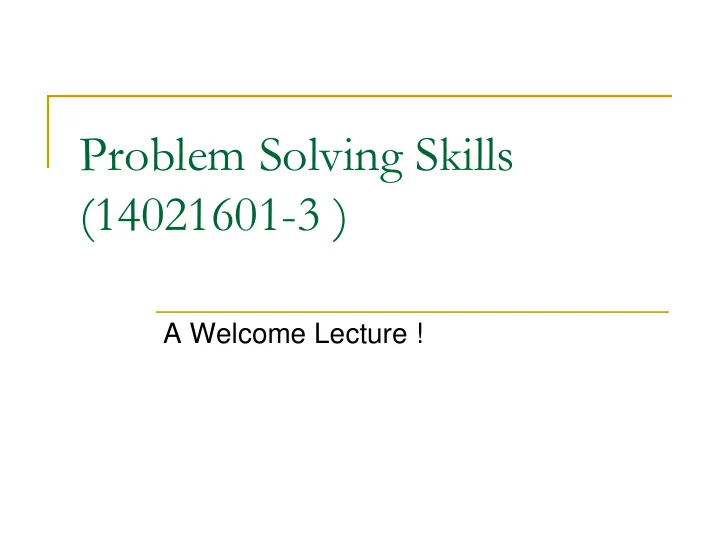

Problem Solving Skills (14021601-3 ) A Welcome Lecture !
What Motivated This Course? Improving students ’ analytical and proving (argue) abilities Improving student ’ s ability to design and develop algorithms
Goals of This Course Make you a better problem solver in general Understand how you operate Recognize limitations and pitfalls Learn general techniques that you can apply to solve problems Prepare you to occupy upper levels of professional hierarchy Success your degree find a high-end job even in adverse conditions work for highly creative companies
Course Organization/Process Learn about yourself Learn problem-solving techniques Solve a wide variety of problems, so as to learn how to apply the specific heuristics Understand errors typically made by poor problem solvers. Learn to avoid.
Know Yourself Whimbey Analytical Skills Inventory (WASI) Myers-Briggs Personality Type (Homework Assignment 1) http://www.humanmetrics.com/cgi-win/JTypes1.htm http://similarminds.com/jung.html (It is good to do a couple of different MB tests, results vary somewhat. Then, read the descriptions.) Soloman & Felder Index of Learning Styles Thomas-Kilmann Conflict Mode Instrument
I took the test 6
Problem Solving Skills (14021601-3 ) Instructor Hassen Sallay, Ph.D. Office: 1137, Email: hmsallay@uqu.edu.sa, hmsallay@gmail.com Text Book Algorithmic Problem Solving, R. Blackhouse, John Wiley & Sons, 2011, ISBN-13: 978-0470684535 Puzzle-based Learning: Introduction to critical thinking, mathematics, and problem solving. Matthew Michalewicz,ISBN-13: 978-187646263 Grading Quizzes 20%, midterm 20%, lab exams: 30%, final exam 30% Course web page http://amansystem.com/?c=people/sallay/PSS
Getting Started with a Problem “ Eighty percent of success is showing up. ” Woody Allen “ Success is 1% inspiration and 99% perspiration. ” – Thomas Edison. To successfully solve any problem, the most important step is to get actively involved. The Principle of Intimate Engagement: You must commit to the problem “ Roll up your sleeves ” “ Get your hands dirty. ” 8
The key premise: Problem solving is not an innate ability (you either have it or you don ’ t). It ’ s a skill that can be learned and honed.
What Kinds of Problems? Puzzles Math problems (simple math) Algorithmic problems (will very require basic programming skills)
Easy vs. Hard Problems Exercises: (e.g. compute 10! without a calculator) Easy problems: See the answer Medium problems: See the answer once you engage Hard problems: You need strategies for coming up with a potential solution, sometimes for even getting started. Open-ended problems are often like this. Often, multiple possible solutions, you need a strategy to choose “ the best ” one. 11
Effective vs. Ineffective Problem Solvers Effective: Believe that problems can be solved through the use of heuristics and careful persistent analysis Ineffective: Believe ``You either know it or you don't.'' Effective: Active in the problem-solving process: draw figures, make sketches, ask questions of themselves and others. Ineffective: Don't seem to understand the level of personal effort needed to solve the problem. Effective: Take great care to understand all the facts and relationships accurately. Ineffective: Make judgments without checking for accuracy 12
Mental Toughness Need the attributes of confidence and concentration Confidence comes with practice Attack a new problem with an optimistic attitude Unfortunately, it takes time You can ’ t turn it on and off at will Need to develop a life-long habit 13
Engagers vs. Dismissers Engagers typically have a history of success with problem solving. Dismissers have a history of failure. You might be an engager for one type of problem, and a dismisser for another. You can “ intervene with yourself ” to change your attitude of dismissal 14
The Mental Block Many students do significant problem solving for recreation (computer games, recreational puzzles.) These same students might dismiss math and analytical computer science problems due to a historical lack of success (the mental block) To be successful in life you will need to find ways to get over any mental blocks you have Learn to transfer successful problem-solving strategies from one part of your life to other parts. Example: Writing is a lot like programming 15
Example Problem Connect each box with its same-letter mate without letting the lines cross or leaving the large box. (Actual problem used in software company job interview) B A C A C B 16
Strategy: solve a simpler problem first. B A C C A C B A 17
Heuristic: Wishful Thinking B B A C C A A A C B C B B B A A C C A A C B C B
The 9 coin problem 9 coins that look alike. One is fake, can be heavier or lighter (not known). Using a simple balance scale and 3 weighings, single out the fake one. Hint: solve a simpler problem first. Which one? 19
The solution for 3 coins: the weighings are: 1 against 2 1 against 3 Both of these can have three outcomes: fall to the left (l), fall to the right (r), or balance (b). The following table gives the answer for each of these outcomes: 20
outcome fake coin # why: -------------------------------------------------------------------- l l 1 too heavy l b 2 too light l r (not possible) b l 3 too light b b no fake coin b r 3 too heavy r l (not possible) r b 2 too heavy r r 1 too light
The solution for 9 coins: Step 1. Divide 9 coins into 3 piles of 3 coins each. Use the 3-coin strategy to weigh: pile 1 against pile 2 pile 1 against pile 3 From Step 1, you will determine: a) which pile contains the fake and b) if the fake is heavier or lighter. Step 2: Weigh 2 coins from the pile that contains fake. Total # of weighings: 2+1 = 3. For 12 coins problem see https://wn.com/12coins
Any Question ???
Recommend
More recommend